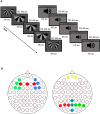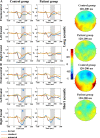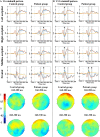A comparison of visual and acoustic mismatch negativity as potential biomarkers in schizophrenia
- PMID: 38200103
- PMCID: PMC10782025
- DOI: 10.1038/s41598-023-49983-5
A comparison of visual and acoustic mismatch negativity as potential biomarkers in schizophrenia
Abstract
Mismatch negativity (MMN) is an event-related potential (ERP) component generated when an unexpected deviant stimulus occurs in a pattern of standard stimuli. Several studies showed that the MMN response to both auditory and visual stimuli is attenuated in schizophrenia. While previous studies investigated auditory and visual MMN in different cohorts, here we examined the potential clinical utility of MMN responses to auditory and visual stimuli within the same group of patients. Altogether 39 patients with schizophrenia and 39 healthy controls matched in age, gender, and education were enrolled. We recorded EEG using 64 channels in eight experimental blocks where we presented auditory and visual stimulus sequences. Mismatch responses were obtained by subtracting responses to standard from the physically identical deviant stimuli. We found a significant MMN response to the acoustic stimuli in the control group, whereas no significant mismatch response was observed in the patient group. The group difference was significant for the acoustic stimuli. The 12 vane windmill pattern evoked a significant MMN response in the early time window in the control group but not in the patient group. The 6 vane windmill pattern evoked MMN only in the patient group. However, we found no significant difference between the groups. Furthermore, we found no correlation between the clinical variables and the MMN amplitudes. Our results suggest that predictive processes underlying mismatch generation in patients with schizophrenia may be more affected in the acoustic compared to the visual domain. Acoustic MMN tends to be a more promising biomarker in schizophrenia.
© 2024. The Author(s).
Conflict of interest statement
The authors declare no competing interests.
Figures



Similar articles
-
Elementary sensory deficits in schizophrenia indexed by impaired visual mismatch negativity.Schizophr Res. 2015 Aug;166(1-3):164-70. doi: 10.1016/j.schres.2015.05.011. Epub 2015 Jun 11. Schizophr Res. 2015. PMID: 26072712
-
Auditory Mismatch Negativity and P300a Elicited by the "Optimal" Multi-feature Paradigm in Early Schizophrenia.Clin EEG Neurosci. 2018 Jul;49(4):238-247. doi: 10.1177/1550059418761459. Epub 2018 Mar 4. Clin EEG Neurosci. 2018. PMID: 29502452
-
Do Auditory Mismatch Responses Differ Between Acoustic Features?Front Hum Neurosci. 2021 Feb 1;15:613903. doi: 10.3389/fnhum.2021.613903. eCollection 2021. Front Hum Neurosci. 2021. PMID: 33597853 Free PMC article.
-
Systematic review and meta-analysis of the visual mismatch negativity in schizophrenia.Eur J Neurosci. 2024 Jun;59(11):2863-2874. doi: 10.1111/ejn.16355. Epub 2024 May 13. Eur J Neurosci. 2024. PMID: 38739367
-
Mismatch Negativity in First-Episode Schizophrenia: A Meta-Analysis.Clin EEG Neurosci. 2017 Jan;48(1):3-10. doi: 10.1177/1550059416645980. Epub 2016 May 11. Clin EEG Neurosci. 2017. PMID: 27170669 Free PMC article. Review.
Cited by
-
Predicting the unpredicted … brain response: A systematic review of the feature-related visual mismatch negativity (vMMN) and the experimental parameters that affect it.PLoS One. 2025 Feb 27;20(2):e0314415. doi: 10.1371/journal.pone.0314415. eCollection 2025. PLoS One. 2025. PMID: 40014603 Free PMC article.
-
Oddball Evoked Deviant Responses Reflect Complex Context-Dependent Expectations in Mouse V1.J Neurosci. 2025 Jul 16;45(29):e1859242025. doi: 10.1523/JNEUROSCI.1859-24.2025. J Neurosci. 2025. PMID: 40550696
References
MeSH terms
Substances
Grants and funding
LinkOut - more resources
Full Text Sources
Medical

